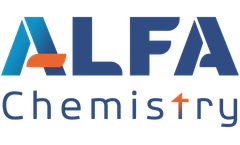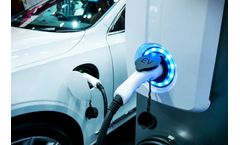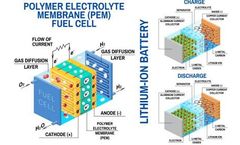Energy Storage Device Articles & Analysis
18 articles found
In the field of electronics, fullerene has been utilized in organic photovoltaic cells, where its ability to absorb light efficiently and transport charge makes it an ideal material for solar energy conversion. The incorporation of fullerene derivatives into the active layer of solar cells enhances their efficiency and stability. ...
ByMatexcel
Its unique properties make it an ideal choice for a wide range of applications, from flexible electronics to energy storage devices. Properties of Graphene Conductive Ink Graphene, a single layer of carbon atoms arranged in a two-dimensional honeycomb lattice, exhibits remarkable properties that set it apart from other materials. ...
The Climate Institute seeks partnerships with startup initiatives and emerging technology development efforts that transform renewable energy systems. We welcome initiatives and demonstration projects to help advance meaningful climate solutions. The Climate Institute supports our colleagues and partners working on emerging technologies by providing research assistance, intern support, ...
Moreover, expandable graphite exhibits good electrical conductivity, making it a suitable candidate for energy storage devices that require rapid charging and discharging capabilities. ...
As we've seen earlier, energy efficiency and cost-effectiveness are critical factors for development projects in developing countries. In areas without access to electricity and where expensive mineral energy sources are not feasible, the use of solar energy is essential, and efficient utilization of solar energy is vital. Installing solar panels can be a significant cost burden, and proper ...
The rapid growth of the electric vehicle market and the increasing demand for portable electronics have driven the need for advanced energy storage systems. In recent years, lithium-ion batteries have emerged as a promising solution due to their high energy density, long cycle life, and low self-discharge rate. However, to further improve their performance and safety, a deeper understanding of ...
For example, specialized ceramics are used for their hardness and compressive strength in dental prosthetics, for their thermal properties in the heat shields on spacecraft, and as insulators in capacitors such as the multilayer ceramic capacitor (MLCC) used for short-term energy storage in devices like smartphones and cars. Certain properties ...
MIEC perovskite oxides have received substantial attention in multiple applications in energy conversion and storage devices, such as solid oxide fuel/electrolysis cells (SOFC/SOEC), oxygen transport membranes (OTMs), electrochemical sensors, and electrocatalysts for water splitting. In applications such as these, the rate of oxygen exchange ...
The International Energy Agency (IEA) recently released the annual World Energy Outlook Report. ...
Research and development (R&D) into novel energy storage materials is important to improve the utility of energy generated from renewable sources, thereby reducing reliance on fossil fuels, a finite resource. Lithium ion batteries are a central to such initiatives, and are increasingly pivotal in green markets like that of hybrid electric vehicles (HEVs). Fossil fuels are a finite resource ...
What is a Fuel Cell? Fuel cells generate electricity through an electrochemical reaction rather than combustion. Inside a fuel cell, hydrogen and oxygen are combined to generate heat, water and electricity. They represent a clean, efficient, dependable, and quiet source of power that does not need to be recharged, but can continue to produce electricity as long as fuel is ...
Data centers are becoming a vital component of today’s digital technology-driven world. From cloud computing to communications to finance, many industries depend on data centers. They centralize services for the storage, management, and transmission of data. Offering these services 24/7, 365 days a year requires a lot of energy. According to Data Center Knowledge, 2% of our nation’s ...
ByAKCP
A Waterproof Supercapacitor is a new type of energy storage device, different between a conventional capacitor and a rechargeable battery. ...
Brief introduction of coin cell supercapacitor Supercapacitor or double layer capacitor is a brand a new type of energy storage device. It is one of the most advanced inventions in recent years, which is much better than conventional capacitor from many aspects. ...
In the future smart grid, improvement of power system economic cost effectiveness by suitable integration of distributed energy resources (DERs) is a critical challenge. An agent–based framework is proposed in this paper for developing suitable control strategies for operations of four different types of residential–level DERs, which are storage ...
This paper is devoted to control strategies for an active battery and supercapacitor hybrid energy storage system using the master-slave control scheme, where the charging and discharging currents of the supercapacitor are dependent on that of battery and the current sharing ratio depends upon the load conditions. A small-signal model is proposed, which considers ...
Synthesis and characterisation of nanostructured vanadium oxide based systems and their application in energy storage devices, namely supercapacitors, is presented. Vanadium oxide has been synthesised using a hydrothermal route in presence of various templates. ...
In this context, an integrated electrification solution based on a photovoltaic generator along with an appropriate energy storage device is investigated. One of the main targets of the proposed solution is to maximise the solar energy exploitation of the area at minimum electricity generation cost, while special emphasis is ...




![[Wellspring] - Energy Storage Device Supercapacitor Technology [Wellspring] - Energy Storage Device Supercapacitor Technology](https://d32zuqhgcrpxli.cloudfront.net/eyJidWNrZXQiOiJlZS1maWxlcyIsImtleSI6ImZpbGVzLzExNDA4OC9hcnRpY2xlcy8xMTA0OTQ1LzExNDA4OF82XzIwMjMwNDE5MDQyNDI4MjQwMTEzX3Jhdy5wbmciLCJlZGl0cyI6eyJyZXNpemUiOnsiZml0IjoiY29udGFpbiIsImJhY2tncm91bmQiOnsiciI6MjU1LCJnIjoyNTUsImIiOjI1NSwiYWxwaGEiOjF9LCJ3aWR0aCI6MjQwLCJoZWlnaHQiOjE0NX19fQ==)









